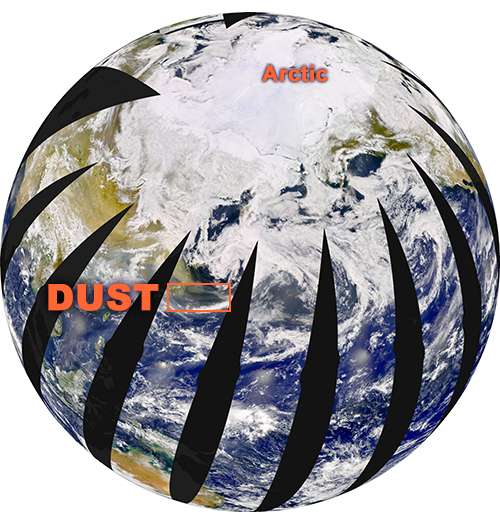Trans-Pacific journey of atmospheric particles

Puzzling skiers, occasional brownish-yellow plumes waft over Colorado ski resorts during winter and spring. Instead of wondering, researchers led by scientists at Pacific Northwest National Laboratory decided to get to the bottom of the plumes' source and content. Their research, now published in the Journal of Atmospheric Sciences found that the plumes hold countless dust particles carried from remote desert areas in Asia and Africa-dust from thousands of miles away travels to the western United States by high-altitude winds over the Pacific Ocean. The researchers also found that the atmospheric lifetime of the larger-sized dust particles is longer than expected. Climate models had always assumed the largest particles would fall out and not be transported such long distances.
Many atmospheric processes, such as long-range transport of particles and their removal from the atmosphere by rain and snow, largely depend on the size of the particle. Just by their size, large particles are seemingly more susceptible to this removal than smaller ones. Climate models use a simplified representation of these complex and size-dependent processes for efficiency's sake. In particular, climate model's predict that the dust particles with large sizes may remain suspended in the atmosphere only over relatively short distances, traveling only hundreds of miles away from their origin.
This study provides new insight into the evolution of large dust particles during their trans-Pacific voyage from Asia and Africa. The surprising conclusion is that these particles may remain suspended in the atmosphere much longer and travel for remarkably larger distances-thousands rather than hundreds of miles as the models predict. The results provide important data for scientists to fine-tune the models with the most recent understanding of atmospheric transport.
PNNL researchers teamed with collaborators from the University of Nevada, University of Wisconsin, Desert Research Institute, and National Oceanic and Atmospheric Administration to identify and characterize a major dust event at the high-elevation research sites in Colorado using an integrated, ground-based dataset of aerosol properties and sophisticated high-resolution simulations of dust evolution using a chemical transport model.
The researchers complemented their dust event characterization by analyzing the corresponding low-resolution simulations from a climate model, satellite observations, and additional ground-based measurements in Asia and the western United States. The team compared their high- and low-resolution simulations to demonstrate a better match for both the ground-based and satellite data.
The new modeling framework-with strongly linked observational and modeling components-has the potential to estimate uncertainties of climate model predictions associated with transport-related processes. The team plans to apply this framework to various climate-important regions wherever integrated, ground-based aerosol property datasets are available.
More information: E. Kassianov et al. Large Contribution of Coarse Mode to Aerosol Microphysical and Optical Properties: Evidence from Ground-Based Observations of a Transpacific Dust Outbreak at a High-Elevation North American Site, Journal of the Atmospheric Sciences (2017).
Provided by Pacific Northwest National Laboratory




















